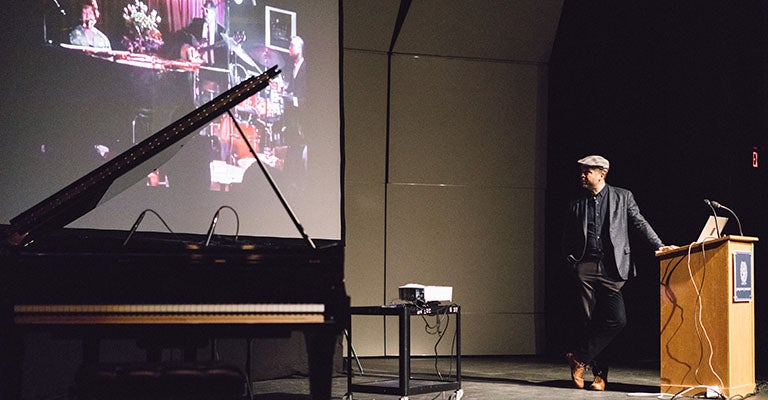Moran Celebrates Monk, Discusses Sense of Place

Jason Moran opened his tenure as Distinguished Artist in Residence last week with a discussion and performance to celebrate the 100th birthday of jazz legend Thelonious Monk. (Photo: Kuna Malik Hamad/Georgetown College)
December 14, 2017 — Jason Moran, Georgetown’s new Distinguished Artist in Residence, gave a lecture and performance last week to celebrate the 100th birthday of jazz legend Thelonious Monk.
“Exploring American Classics,” held this past Thursday at the Davis Performing Arts Center’s Gonda Theatre, featured a three-part program in which the jazz pianist explored thoughts about Monk, talked about the sense of place in music and gave a short performance.
Maurice Jackson, professor of history and African American Studies in the College and an affiliated professor of performing arts (jazz), introduced Moran, who took the stage and promptly began discussing the role music — especially Monk’s music — played in his upbringing.
Biggest Fan
Moran recalled a vivid memory of his parents listening to Thelonious Monk’s “Round Midnight” while watching muted television news coverage of the plane crash that killed Texas Congressman and Congressional Black Caucus Chairman Mickey Leland.
“From that point on, I couldn’t ever separate that I was just hearing a song,” Moran said. “It was always, where am I? What is happening outside of the room? What’s the relationship to everything else around it?”
“In that moment, watching my parents in a place of mourning, listening to Thelonious Monk, was how I would understand how to move forward,” he added. “So instantly, I became the biggest Thelonious Monk fan.”
Burgeoning Career
In describing his early career — moving from Houston to New York, studying at the Manhattan School of Music and his critically acclaimed early work with Blue Note Records — Moran emphasized the importance of a sense of place, which he said wasn’t a common factor among modern jazz musicians.
“Maybe an opera student might get that, but a jazz musician just learns to hunch over the instrument,” Moran said. “My generation was mostly taught to sit down and play, but other eras didn’t have that mentality.”
Moran’s well-received work, both solo and with the group Bandwagon, drew attention beyond the jazz community in the 2000s. He created a much lauded multimedia performance on Monk, received a MacArthur Genius Grant, scored six films (including Ava DuVernay’s Selma and 13th), and became the Kennedy Center’s artistic director for jazz.
Preservation of Place
In a 2015 exhibition at the Venice Biennale, the jazz pianist recreated long-demolished New York jazz venues such as the Savoy and the Three Deuces.
“[The Savoy] is a dollar store now. It’s a nice dollar store, but a dollar store nonetheless,” Moran said. “So I thought, instead of just mythologizing what happened there, why don’t we make a version of the Savoy Ballroom stage?”
At the Georgetown event last week, he called for the preservation of important sites in musical history that are still standing — such as New York’s Village Vanguard — as active spaces for people to experience and create music.
Active Spaces
“How do we turn the corner on active spaces?” he asked. “We need to preserve these places, not as mausoleums, but as active environments.”
Following the discussion of Monk and the role of place in music, Moran gave a 20-minute performance and opened up the room for a question-and-answer session.
His next event as Distinguished Artist in Residence will take place in Spring 2018.